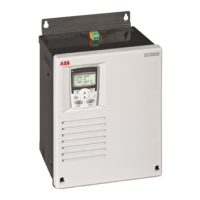127
AP
3ADW000379R0501 DCS550 Manual e e
IN1 = 517, desired signal, this must be defined as a parameter
IN2 = 2201, this must be a defined as a constant
IN1: 16 bit integer (15 bits + sign); desired value
IN2:
16 bit integer (15 bits + sign); group * 100 + index
boolean; true = save in flash, false = don’t save in flash
OUT: 16 bit integer (packed boolean); error code
OUT is IN1 multiplied by (IN2 / 100) plus integrated IN1 multiplied by (IN3 / 100).
( )
∫
+= 1*100/3100/2*1 IIIIO
:
The internal calculation uses 32 bits accuracy to avoid offset errors.
IN1: 16 bit integer (15 bit + sign); error (e.g. speed error)
IN2:
16 bit integer (15 bit + sign); p-part (30 == 0.3, 100 == 1)
16 bit integer (15 bit + sign); i-part (250 == 2.5, 5,000 == 50)
OUT: 16 bit integer (15 bits + sign); the range is limited from -20,000 to +20,000
-Bal
The PI-Bal block initializes the PI block. The PI-Bal block must follow directly behind the PI
block. It can only be used together with the PI block.
-Bal block writes the value of IN2 directly into OUT of the PI block.
When IN1 is false, the PI
-Bal block releases OUT of the PI block. Normal operation continues
starting with the set output value - bumpless transition.
IN1: boolean; true = balance PI block, false = no balancing
IN2:
16 bit integer (15 bits + sign); balance value
not used
IN1 is the input. IN2 and IN3 are the times. OUT increases or decreases until the input value is
reached.

